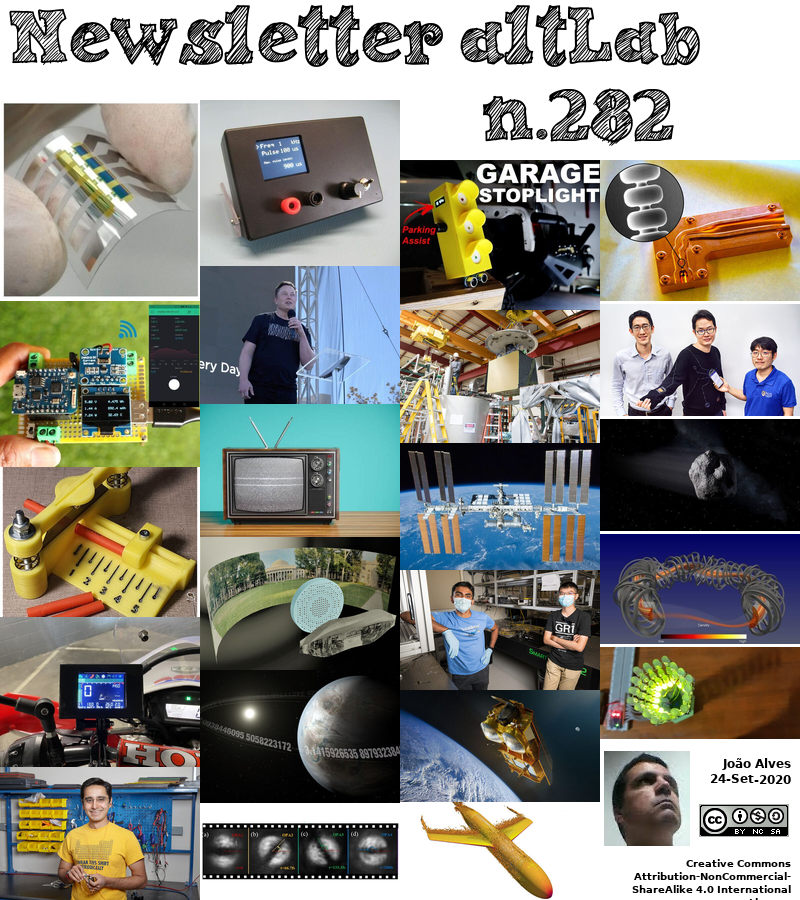2020-09-24 - Nº 282
Editorial
Esta é a Newsletter Nº 282 que se apresenta com o mesmo formato que as anteriores. Se gostar da Newsletter partilhe-a!
Todas as Newsletters encontram-se indexadas no link.
Esta Newsletter tem os seguintes tópicos:
Faz hoje anos que nascia, em 1501, o médico, matemático e astrólogo italiano Girolamo Cardano. Ele foi o primeiro a dar uma descrição clínica da febre tifóide. O seu livro, Ars magna (“Grande Arte”, 1545) foi uma das grandes conquistas da história da álgebra, em que publicou as soluções para as equações cúbicas e quadráticas. As suas invenções mecânicas incluíam a fechadura com combinação, o cardan da bússola consistindo em três anéis concêntricos e a junta universal para transmitir o movimento rotativo em vários ângulos (como usado nos veículos actuais). Ele contribuiu para a hidrodinâmica e sustentou que o movimento perpétuo é impossível, excepto em corpos celestes. Cardano publicou duas enciclopédias de ciências naturais, introduziu a grade Cardan, uma ferramenta criptográfica (1550) e foi um crente ao longo da vida como astrólogo.
Faz também hoje anos que nascia, em 1801, o matemático russo Mikhail Ostrogradsky. Ele contribuiu nas áreas de cálculo integral e física matemática. Ele escreveu livros que ajudaram a melhorar o padrão no ensino da matemática na Rússia. A partir de 1847, ele também serviu como inspector-chefe das ciências matemáticas em escolas militares. Ele é considerado o fundador da escola russa de mecânica teórica, numa ampla gama de tópicos, incluindo calor, elasticidade, teoria da percussão, balística e teoria da probabilidade. Ele desenvolveu métodos de análise, como em problemas de valor limite e separação de variáveis. Mais importante ainda, ele lidou com princípios variáveis.
Faz igualmente hoje anos que nascia, em 1870, o químico, engenheiro e inventor francês Georges Claude. Ele inventou a luz néon, que foi a precursora da luz fluorescente. Claude foi o primeiro a aplicar uma descarga eléctrica a um tubo selado de gás néon, por volta de 1902 e a fazer uma lâmpada néon ("Néon" do grego neos, que significa "gás novo"). Ele exibiu publicamente a lâmpada néon a 11 de Dezembro de 1910 em Paris.
Por fim, faz hoje anos que nascia, em 1898, a astrofísica americana Charlotte Moore Sitterly. Ela organizou, analisou e publicou livros definitivos sobre o espectro solar e os multipletos de linha espectral. De 1945 a 90 anos, ela conduziu este trabalho no Escritório Nacional de Padrões dos EUA e no Laboratório de Pesquisa Naval. Ela detectou que o tecnécio, um elemento instável (anteriormente conhecido apenas como resultado de experiências de laboratório com reacções nucleares) existe na natureza. Ela fez contribuições importantes para a compilação de tabelas para níveis de energia atómica associados a espectros ópticos, que agora são material de referência padrão. Como instrumentos transportados em foguetes espaciais forneceram novos dados no ultravioleta, ela estendeu essas tabelas além do alcance óptico. Ela foi premiada com a Medalha Bruce em 1990.
Nesta semana que passou ficámos a conhecer a história de uma aldeia do País de Gales que durante 18 meses ficava sem Internet às 7 horas da manhã sem qualquer razão. Depois e inúmeras queixas, troca de equipamentos, e tendo esgotado todas as outras vias, os engenheiro foram para o terreno fazer um teste final para ver se a falha estava a ser causada por um fenómeno conhecido como SHINE (Single High-level Impulse Noise), onde a interferência eléctrica é emitida por um aparelho que pode, então, ter um impacto na banda larga conectividade. O que descobriram foi que efectivamente existia um aparelho de televisão bastante antigo que era ligado todos os dias às 7 horas da manhã e provocava o referido efeito.
Também nesta semana que passou realizou-se o evento da Tesla designado por "Battery Day". No evento foram apresentadas inúmeras novidades das quais se destacam muitas melhorias ao nível do desenvolvimento das baterias que equipam os carros que passam pelo seu processo de fabrico, melhorias tecnológicas ao nível dos materiais usados e da sua dimensão. Estas melhorias poderão ter como consequência uma redução estimada de cerca de 56% do custo $/kWh. Estas novas baterias deverão ficar disponíveis em cerca de 18 meses e darão um aumento de autonomia de cerca de 16%. Foi também falada da intenção de lançar um veiculo de 25.000 USD e do Model S Plaid. Este ultimo, que já pode ser encomendado, tem 1.100 cv e um custo de 140.000 USD e que terá a "aceleração mais rápida de 0 aos 100 km/h de qualquer carro de produção" (cerca de 2 segundos) contando com uma autonomia até 840 Km.
Na Newsletter desta semana apresentamos diversas noticias, artigos científicos assim como projetos de maker. São apresentadas as revistas Hack Space Magazine nº 35 de Outubro, a MagPI nº 98 de Outubro e a newelectronics de 22 Setembro.
 João Alves ([email protected])
João Alves ([email protected])
O conteúdo da Newsletter encontra-se sob a licença  Creative Commons Attribution-NonCommercial-ShareAlike 4.0 International License.
Creative Commons Attribution-NonCommercial-ShareAlike 4.0 International License.
Novidades da Semana

The strange broadband mystery that plagued a Welsh village - and how it was finally solved
"The 'SAS team' of telecom engineers were called in after service collapsed at 7am every morning. A Welsh village's broadband mystery has finally be been solved after 18 months of frustration for residents. Telecoms engineers turned detectives to probe what was plaguing the broadband connections of residents living in the Powys village of Aberhosan near Machynlleth. For months villagers – along with some neighboring communities – endured poor broadband connectivity and slow speeds every morning at 7am despite repeated visits by engineers to fix the fault. Frequent tests proved that the network was working fine and local engineers even replaced large sections of cable that served the village - but the problems remained. Local Openreach engineer Michael Jones to called on the assistance of colleagues from Openreach’s Chief Engineer team – described as the company’s telecoms equivalent of the ‘SAS’." [...]

The 3 biggest things Elon Musk announced at Tesla's big outdoor event
"Elon Musk and other Tesla executives held an unusual outdoor version of the company's annual shareholder meeting and a "Battery Day" presentation on Tuesday afternoon in Fremont, California. Among the touted advancements in power technology and manufacturing, Musk announced a yet-to-be-named $25,000 Tesla car was in the works thanks to the cost savings in battery production that will touch all of the company's products. A $140,000 "Plaid" edition of the Tesla Model S was also announced, with preorders open now. An unusual setting amid pandemic restrictions The delayed event had severe attendance restrictions in place because of the COVID-19 pandemic. A few randomly selected shareholder attendees watched the proceedings from long rows of parked Tesla cars. Those attending the event responded with honks instead of applause." [...]
Outras Notícias
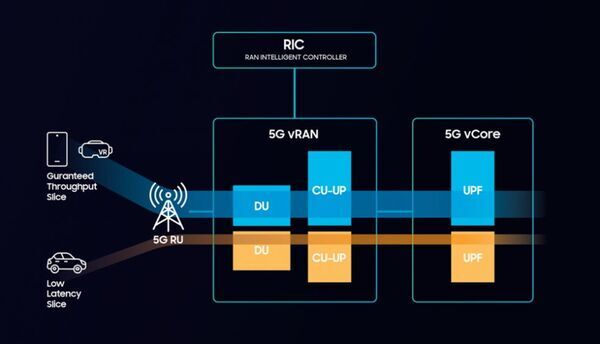
Samsung and KDDI Complete 5G End-to-End Network Slicing Demonstration
"The companies successfully demonstrate network slicing with a RAN Intelligent Controller (RIC) for the first time in the industry Network slicing will enable new business opportunities for mobile operators, creating new value to leverage 5G commercial networks Samsung Electronics and KDDI today announced the successful completion of the first 5G end-to-end (E2E) network slicing demonstration with a RAN Intelligent Controller (RIC) in Tokyo, Japan. The companies showed a glimpse of various new use cases using 5G E2E network slicing on a virtual network that ties together Samsung’s virtualized core, virtualized RAN, and orchestration. 5G E2E network slicing will play a key role for mobile operators by enabling multiple virtual networks to be created within a single physical network infrastructure. Each virtual network will have different service characteristics, referred to as ‘slices’ that allow mobile carriers to create new services and business models. For instance, within the same mobile network, operators can create a low latency-focused slice dedicated to automated vehicle drivers, while a separate high bandwidth slice can be created for video streamers. Both slices can be provided simultaneously without deploying additional network resources or hindering the quality of service in either case." [...]

Discovery: User Manual of the Oldest Surviving Computer in the World
"The Zuse Z4 is considered the oldest preserved computer in the world. Manufactured in 1945 and overhauled and expanded in 1949/1950, the relay machine was in operation on loan at the ETH Zurich from 1950 to 1955. Today the huge digital computer is located in the Deutsches Museum in Munich. The operating instructions for the Z4 were lost for a long time. In 1950, ETH Zurich was the only university in continental Europe with a functioning tape-controlled computer. From the 1940s, only one other computer survived: the Csirac vacuum tube computer (1949)." [...]

ISS successfully dodges 'unknown piece of space debris'
"Space junk was coming too close for comfort to the International Space Station, so it got out of the way. With space junk piling up around our planet, the International Space Station needed to perform a last-minute avoidance maneuver Tuesday to steer clear of an "unknown piece of space debris expected to pass within several kilometers." Mission Control in Houston conducted the move at 2:19 p.m. PT using the Russian Progress resupply spacecraft docked to the ISS to help nudge the station out of harm's way. "Out of an abundance of caution, the Expedition 63 crew will relocate to their Soyuz spacecraft until the debris has passed by the station," NASA said in a statement prior to the move. The maneuver went off smoothly, NASA administrator Jim Bridenstine reported. "The astronauts are coming out of safe haven," he tweeted after the ISS relocated." [...]

School Bus-Size Asteroid to Safely Zoom Past Earth
" small near-Earth asteroid (or NEA) will briefly visit Earth's neighborhood on Thursday, Sept. 24, zooming past at a distance of about 13,000 miles (22,000 kilometers) above our planet's surface. The asteroid will make its close approach below the ring of geostationary satellites orbiting about 22,000 miles (36,000 kilometers) away from Earth. Based on its brightness, scientists estimate that 2020 SW is roughly 15 to 30 feet (5 to 10 meters) wide - or about the size of a small school bus. Although it's not on an impact trajectory with Earth, if it were, the space rock would almost certainly break up high in the atmosphere, becoming a bright meteor known as a fireball. "There are a large number of tiny asteroids like this one, and several of them approach our planet as close as this several times every year," said Paul Chodas, director of the Center for Near-Earth Object Studies (CNEOS) at NASA's Jet Propulsion Laboratory in Southern California. "In fact, asteroids of this size impact our atmosphere at an average rate of about once every year or two."" [...]
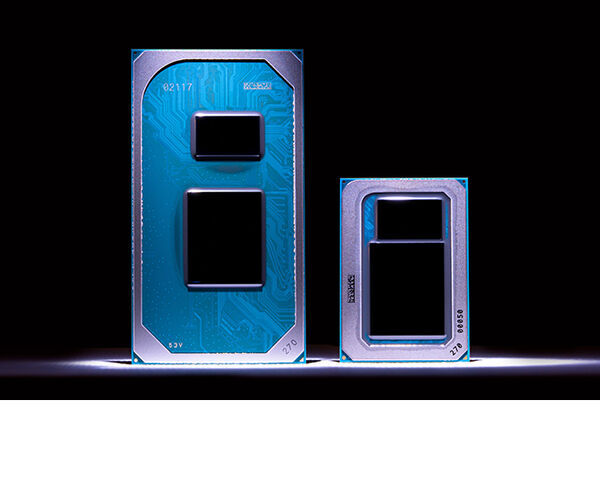
IoT-Enhanced Processors Increase Performance, AI, Security
"Today at the Intel Industrial Summit 2020, Intel announced new enhanced internet of things (IoT) capabilities. The 11th Gen Intel® Core™ processors, Intel Atom® x6000E series, and Intel® Pentium® and Celeron® N and J series bring new artificial intelligence (AI), security, functional safety and real-time capabilities to edge customers. With a robust hardware and software portfolio, an unparalleled ecosystem and 15,000 customer deployments globally, Intel is providing robust solutions for the $65 billion edge silicon market opportunity by 2024. “By 2023, up to 70% of all enterprises will process data at the edge.1 11th Gen Intel Core processors, Intel Atom x6000E series, and Intel Pentium and Celeron N and J series processors represent our most significant step forward yet in enhancements for IoT, bringing features that address our customers’ current needs, while setting the foundation for capabilities with advancements in AI and 5G.” –John Healy, Intel vice president of the Internet of Things Group and general manager of Platform Management and Customer Engineering Intel works closely with customers to build proofs of concept, optimize solutions and collect feedback along the way. Innovations delivered with 11th Gen Intel Core processors, Intel Atom x6000E series, and Intel Pentium and Celeron N and J series processors are a response to challenges felt across the IoT industry: edge complexity, total cost of ownership and a range of environmental conditions. Combining a common and seamless developer experience with software and tools like the Edge Software Hub’s Edge Insights for Industrial and the Intel® Distribution of OpenVINO™ toolkit, Intel helps customers and developers get to market faster and deliver more powerful outcomes with optimized, containerized packages to enable sensing, vision, automation and other transformative edge applications." [...]
Toshiba and Japan Semiconductor Develop Technology to Improve Reliability of Pch-LDMOS for Analog ICs
"Toshiba Electronic Devices & Storage Corporation (“Toshiba”) and its manufacturing subsidiary, Japan Semiconductor Corporation, have developed technology to improve the reliability of P-channel Laterally Double Diffused MOS (Pch-LDMOS) technology for analog ICs. The companies clarified the cause of degradation of breakdown voltage that occurs in the drain avalanche hot-carrier (DAHC) stress test, a reliability test for LDMOS, and identified a device structure that suppresses the degradation. Details were reported at the IEEE-sponsored International Symposium on Power Semiconductor Devices and ICs 2020 (ISPSD 2020) held online. The electrification of vehicles and automation of industrial equipment is stimulating demand for analog ICs that can maintain high reliability over the long term in low- and high-temperature environments. This has drawn increasing interest in LDMOS, which has low on-resistance that makes it suitable for a wide range of application. In the drain avalanche hot-carrier (DAHC) stress test, LDMOS reliability is evaluated by applying a medium voltage to its gate over a long period." [...]
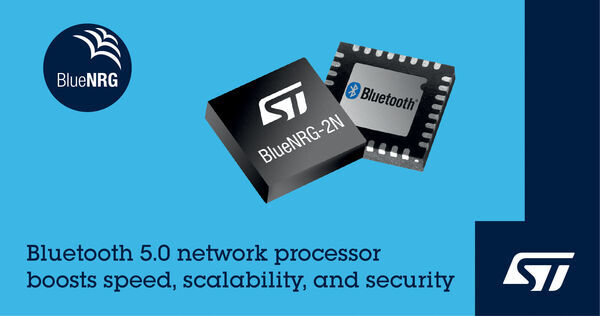
STMicroelectronics Reveals BlueNRG-2N Network Processor Combining Convenience and Scalability, with Bluetooth® 5.0 Features and Security
"STMicroelectronics has unveiled the BlueNRG-2N Bluetooth 5.0-certified network processor, lowering power consumption and adding support for the latest Bluetooth features that increase data throughput and enhance privacy and security. The BlueNRG-2N network coprocessor comes pre-programmed, ready for connecting to a host controller to provide Bluetooth connectivity. Not only simplifying product manufacture, the co-processor allows scaling the performance, features, and cost of the host system independently. Designers of products such as smart medical wearables, PC peripherals, remote controls, lighting, industrial and home automation can thus optimize their choice of microcontroller (MCU) to meet specific model requirements. The latest Bluetooth enhancements featured in BlueNRG-2N include support for Data Length Extension, which accelerates over-the-air (OTA) firmware updates by as much as 2.5 times and raises data transfers to 700kbit/s at the application level. In addition, with support for Bluetooth LE Privacy 1.2, BlueNRG-2N changes address frequently without host-processor involvement to prevent unwanted tracking with minimal impact on system power consumption." [...]

Plans underway for new polar ice and snow topography mission
"Monitoring the cryosphere is essential to fully assess, predict and adapt to climate variability and change. Given the importance of this fragile component of the Earth system, today ESA, along with Airbus Defence and Space and Thales Alenia Space, have signed a contract to develop the Copernicus Polar Ice and Snow Topography Altimeter mission, known as CRISTAL. With a launch planned in 2027, the CRISTAL mission will carry, for the first time on a polar mission, a dual-frequency radar altimeter, and microwave radiometer, that will measure and monitor sea-ice thickness, overlying snow depth and ice-sheet elevations. These data will support maritime operations in the polar oceans and contribute to a better understanding of climate processes. CRISTAL will also support applications related to coastal and inland waters, as well as providing observations of ocean topography. The mission will ensure the long-term continuation of radar altimetry ice elevation and topographic change records, following on from previous missions such as ESA’s Earth Explorer CryoSat mission and other heritage missions." [...]
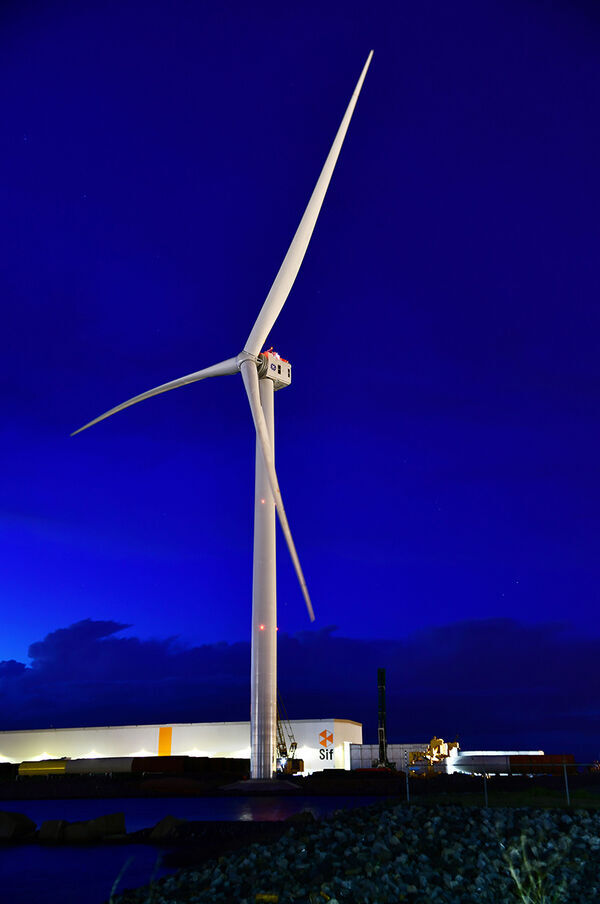
Power Move: GE Signs First Contract For The World’s Most Powerful Offshore Wind Turbine In Operation
"John Lavelle has seen many powerful machines during his nearly four decades as a GE engineer. But none measure up to the Haliade-X, the world’s most powerful offshore wind turbine in operation. The turbine set a world record earlier this year when it generated 288 megawatt-hours of electrical energy in a single day. That’s enough to power 30,000 homes in Rotterdam, where the first prototype is located. Today the turbine hit another milestone: GE Renewable Energy signed the first contract for the powerful machine. Specifically, its Offshore Wind unit, where Lavelle now serves as CEO, will supply 190 Haliade-X 13 MW turbines for Dogger Bank A and Dogger Bank B, the first two phases of what will be the world’s largest offshore wind farm." [...]
Ciência e Tecnologia

Astronomers discover an Earth-sized “pi planet” with a 3.14-day orbit
"The rocky world, with its baking-hot surface, is likely not habitable. In a delightful alignment of astronomy and mathematics, scientists at MIT and elsewhere have discovered a “pi Earth” — an Earth-sized planet that zips around its star every 3.14 days, in an orbit reminiscent of the universal mathematics constant. The researchers discovered signals of the planet in data taken in 2017 by the NASA Kepler Space Telescope’s K2 mission. By zeroing in on the system earlier this year with SPECULOOS, a network of ground-based telescopes, the team confirmed that the signals were of a planet orbiting its star. And indeed, the planet appears to still be circling its star today, with a pi-like period, every 3.14 days. “The planet moves like clockwork,” says Prajwal Niraula, a graduate student in MIT’s Department of Earth, Atmospheric and Planetary Sciences (EAPS), who is the lead author of a paper published today in the Astronomical Journal, titled: “π Earth: a 3.14-day Earth-sized Planet from K2’s Kitchen Served Warm by the SPECULOOS Team.” “Everyone needs a bit of fun these days,” says co-author Julien de Wit, of both the paper title and the discovery of the pi planet itself." [...]
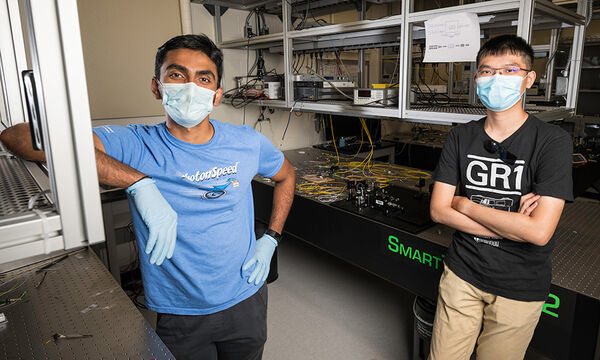
Rochester researchers document record-setting optical fiber
"Work shows the innovative fiber—made of seven capillaries surrounding a hollow core—may be a promising platform for quantum information processing and other applications. An innovative optical fiber greatly reduces the “noise” interfering with the signals it transmits compared to the single-mode fibers now widely used, researchers at the University of Rochester report. The anti-resonant hollow core fiber, created by researchers at the University of Central Florida, produces the lowest levels ever recorded from interference caused by the vibration of quantum material—known as acoustic phonons—in the glass as the signals travel through the fiber at room temperatures. The lab’s findings demonstrate that the fiber is a “promising platform for low-noise applications, such as for quantum information processing and optical communications,” writes lead author Arjun Iyer, a graduate research associate in the lab of William Renninger, an assistant professor of optics at Rochester. To document the properties of the fiber, researchers in Renninger’s lab developed a highly sensitive measuring technique. Their findings are reported in a paper published in APL Photonics." [...]

Quieter wind beneath the wings
"The ability to efficiently simulate the noise generated by wings and propellers promises to accelerate the development of quieter aircraft and turbines. A new simulation approach has enabled a first practical, and highly accurate, computation of the noise characteristics of complex three-dimensional airfoil designs under extreme operating conditions. By shortening simulations that would have taken months or weeks to run to just days or hours, the new approach could accelerate the development of quieter airfoil designs to enable the next generation of aircraft and urban airborne vehicles. “Aircraft noise is already a problem for many communities located near major airports, and this will only get worse with the expanded use of drones and, in the future, air taxis and private airborne vehicles,” says Radouan Boukharfane, a postdoc at KAUST. Airfoils—wings, propellers and turbine blades—are typically designed and refined using relatively fast applied mathematical techniques. However, characteristics like noise generation are more complex." [...]
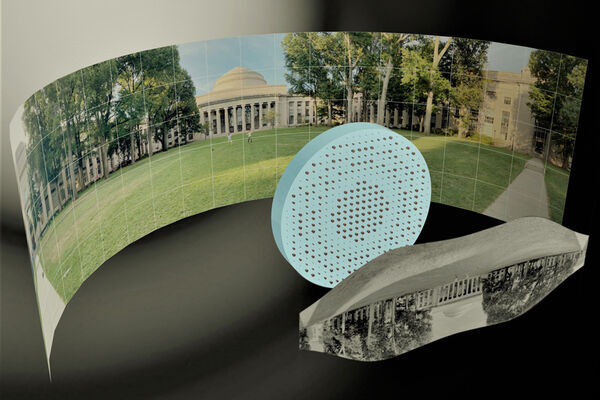
Engineers produce a fisheye lens that’s completely flat
"The single piece of glass produces crisp panoramic images. To capture panoramic views in a single shot, photographers typically use fisheye lenses — ultra-wide-angle lenses made from multiple pieces of curved glass, which distort incoming light to produce wide, bubble-like images. Their spherical, multipiece design makes fisheye lenses inherently bulky and often costly to produce. Now engineers at MIT and the University of Massachusetts at Lowell have designed a wide-angle lens that is completely flat. It is the first flat fisheye lens to produce crisp, 180-degree panoramic images. The design is a type of “metalens,” a wafer-thin material patterned with microscopic features that work together to manipulate light in a specific way." [...]
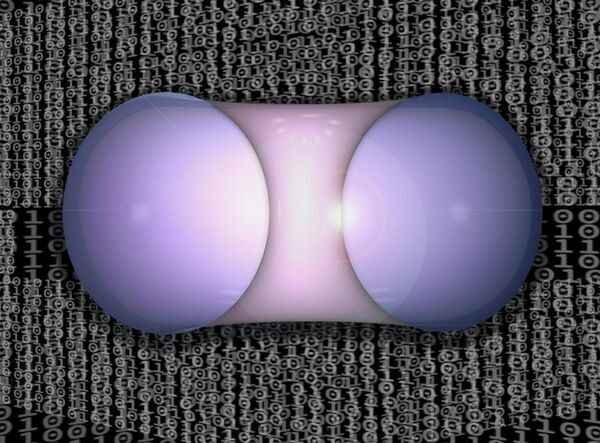
Scientists develop forecasting technique that could help advance quest for fusion energy
"Bringing the power of the sun to Earth requires sound theory, good engineering, and a little finesse. The process entails trapping charged, ultra-hot gas known as plasma(link is external) so its particles can fuse and release enormous amounts of energy. The most widely used facilities for this process are doughnut-shaped tokamaks that hold plasma in place with strong magnets that are precisely shaped and positioned. But errors in the shaping or placement of these magnets can lead to poor confinement and loss of plasma, shutting down fusion reactions. Now, an international group of researchers led by physicists at the U.S. Department of Energy’s (DOE) Princeton Plasma Physics Laboratory (PPPL) has developed a technique that forecasts how tokamaks(link is external) might respond to these unwanted magnetic errors. These forecasts could help engineers design fusion facilities that efficiently create a virtually inexhaustible supply of safe and clean fusion energy to generate electricity." [...]
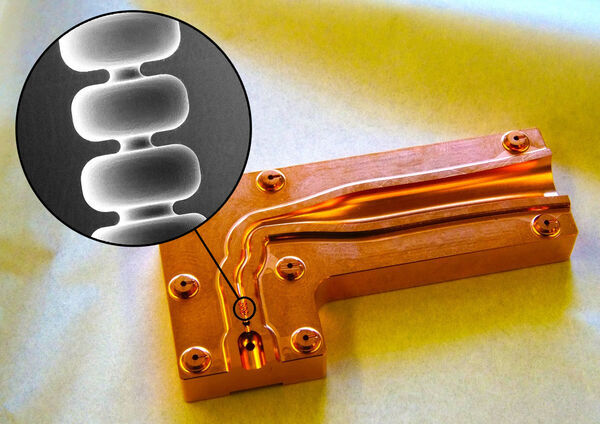
SLAC invention could make particle accelerators 10 times smaller
"It uses terahertz radiation to power a miniscule copper accelerator structure. Particle accelerators generate high-energy beams of electrons, protons and ions for a wide range of applications, including particle colliders that shed light on nature’s subatomic components, X-ray lasers that film atoms and molecules during chemical reactions and medical devices for treating cancer. As a rule of thumb, the longer the accelerator, the more powerful it is. Now, a team led by scientists at the Department of Energy’s SLAC National Accelerator Laboratory has invented a new type of accelerator structure that delivers a 10 times larger energy gain over a given distance than conventional ones. This could make accelerators used for a given application 10 times shorter. The key idea behind the technology, described in a recent article in Applied Physics Letters, is to use terahertz radiation to boost particle energies." [...]
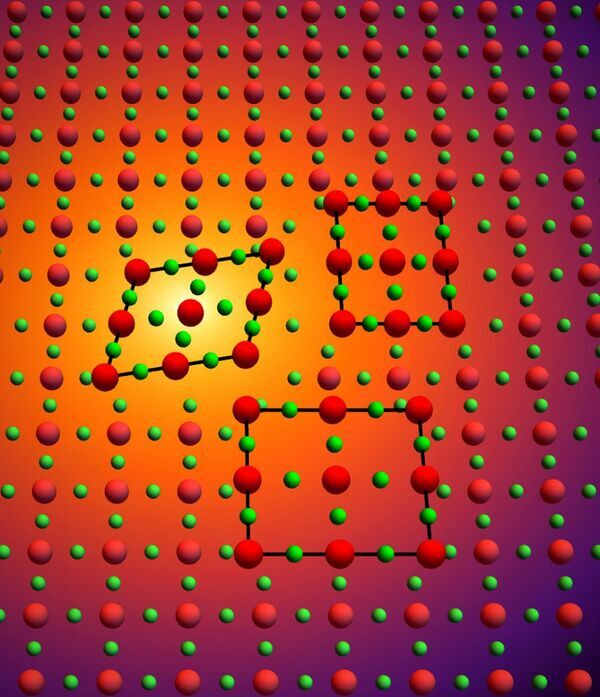
Researchers identify new type of superconductor
"Until now, the history of superconducting materials has been a tale of two types: s-wave and d-wave. Now, Cornell researchers – led by Brad Ramshaw, the Dick & Dale Reis Johnson Assistant Professor in the College of Arts and Sciences – have discovered a possible third type: g-wave. Their paper, “Thermodynamic Evidence for a Two-Component Superconducting Order Parameter in Sr2RuO4,” published Sept. 21 in Nature Physics. The lead author is doctoral student Sayak Ghosh, M.S. ’19. Electrons in superconductors move together in what are known as Cooper pairs." [...]
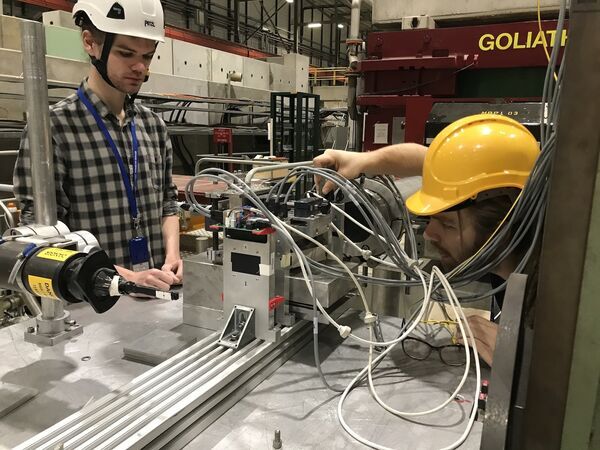
NA63 makes crystal-clear study of radiation reaction
"The NA63 collaboration has made a high-precision study of the phenomenon of radiation reaction, using particle beams and crystals Place a charged particle in an electromagnetic field and the particle will accelerate and give off radiation. Typically, the emitted radiation has little effect on the particle’s motion. However, if the acceleration is extremely large, as is the case for high-energy electrons or positrons in strong electromagnetic fields, the emitted radiation will drastically slow down the particle. The effect, known as radiation reaction, has been recognised since the beginning of the twentieth century, and is relevant in several branches of physics, from accelerator physics to astrophysics. But until now it has been difficult to pin down the maths that best describes the phenomenon. In a paper recently published in Physical Review D, the NA63 collaboration reports a high-precision study of the phenomenon that shows that an equation proposed long ago does the job remarkably well." [...]

SwRI instruments aboard Rosetta help detect unexpected ultraviolet aurora at a comet
"Data from Southwest Research Institute-led instruments aboard ESA’s Rosetta spacecraft have helped reveal auroral emissions in the far ultraviolet around a comet for the first time. At Earth, auroras are formed when charged particles from the Sun follow our planet’s magnetic field lines to the north and south poles. There, solar particles strike atoms and molecules in Earth’s atmosphere, creating shimmering curtains of colorful light in high-latitude skies. Similar phenomena have been seen at various planets and moons in our solar system and even around a distant star. SwRI’s instruments, the Alice far-ultraviolet (FUV) spectrograph and the Ion and Electron Sensor (IES), aided in detecting these novel phenomena at comet 67P/Churyumov-Gerasimenko (67P/C-G). “Charged particles from the Sun streaming towards the comet in the solar wind interact with the gas surrounding the comet’s icy, dusty nucleus and create the auroras,” said SwRI Vice President Dr. Jim Burch who leads IES." [...]
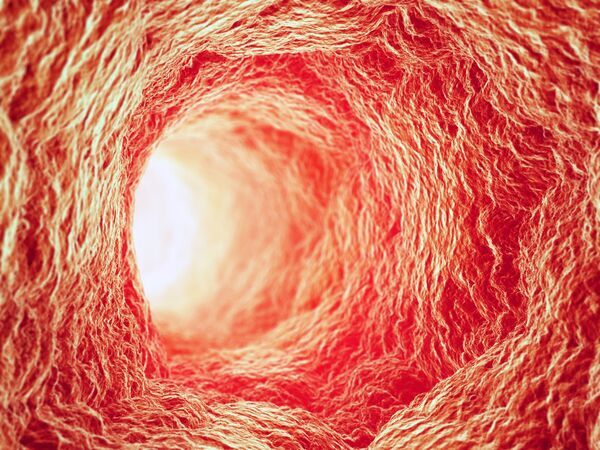
Soft robots, origami combine for potential way to deliver medical treatments
"Researchers have found a way to send tiny, soft robots into humans, potentially opening the door for less invasive surgeries and ways to deliver treatments for conditions ranging from colon polyps to stomach cancer to aortic artery blockages. The researchers from The Ohio State University and the Georgia Institute of Technology detailed their discovery, which makes use of the ancient Japanese practice of origami, in a study published Sept. 14 in the Proceedings of the National Academy of Sciences. Under this system, doctors would use magnetic fields to steer the soft robot inside the body, bringing medications or treatments to places that need them, said Renee Zhao, corresponding author of the paper and assistant professor of mechanical and aerospace engineering at Ohio State. “The robot is like a small actuator,” Zhao said, “but because we can apply magnetic fields, we can send it into the body without a tether, so it’s wireless. That makes it significantly less invasive than our current technologies.” That soft robot is made of magnetic polymer, a soft composite embedded with magnetic particles that can be controlled remotely. Robotic delivery of medical treatment is not a new concept, but most previous designs used traditional robots, made of stiff, hard materials." [...]
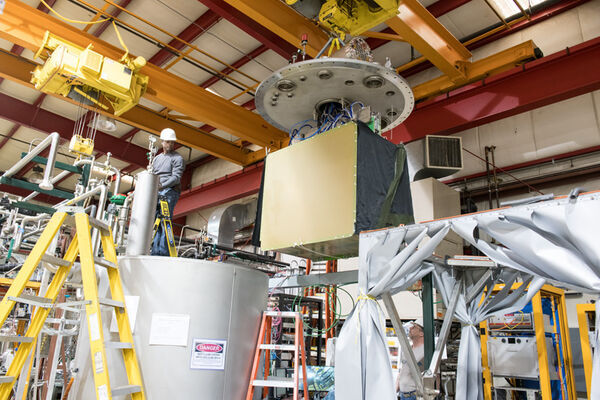
ICEBERG tests future neutrino detector systems with ‘beautiful’ results
"The international Deep Underground Neutrino Experiment, or DUNE, hosted by Fermilab, will be huge. In fact, with more than 1,000 collaborators from over 30 countries and five continents, it’s the largest international science project ever hosted in the U.S. To prepare for this massive endeavor, the particle physics community has been taking DUNE technologies for thorough test drives. Over the last decade, the particle detectors ICARUS, MicroBooNE and LArIAT at Fermilab and the ProtoDUNE detectors at CERN have all contributed in one way or another to compiling the deep background knowledge needed to build and operate DUNE, a neutrino detector that will use liquid argon and advanced electronics to capture the passage of the famously elusive particles. In 2019, DUNE preparations entered a new stage as Fermilab established a new testing facility for DUNE detectors: The Integrated Cryostat and Electronics Built for Experimental Research Goals, or ICEBERG. “DUNE’s primary goal is to measure and understand very particular properties of the neutrino, and ICEBERG is a facility where we can confirm that the detector components we’re designing reach the specifications necessary for DUNE to be successful,” said Rory Fitzpatrick, a graduate student at the University of Michigan working on ICEBERG’s photon detectors. The most abundant matter particles in the universe, neutrinos provide a valuable testing ground for particle physics theories." [...]

Why there is no speed limit in the superfluid universe
"Physicists from Lancaster University have established why objects moving through superfluid helium-3 lack a speed limit in a continuation of earlier Lancaster research. Helium-3 is a rare isotope of helium, in which one neutron is missing. It becomes superfluid at extremely low temperatures, enabling unusual properties such as a lack of friction for moving objects. It was thought that the speed of objects moving through superfluid helium-3 was fundamentally limited to the critical Landau velocity, and that exceeding this speed limit would destroy the superfluid. Prior experiments in Lancaster have found that it is not a strict rule and objects can move at much greater speeds without destroying the fragile superfluid state. Now scientists from Lancaster University have found the reason for the absence of the speed limit: exotic particles that stick to all surfaces in the superfluid." [...]
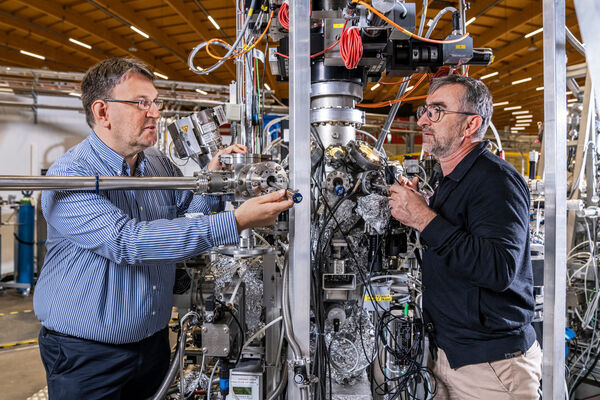
Customising an electronic material
"PSI scientists have gained a fundamental understanding of a highly promising material that could be suited to future data storage applications. Their experiments with strontium-iridium oxide, Sr2IrO4, investigated both the magnetic and electronic properties of the material as a thin film. They also analysed how these properties can be systematically controlled by manipulating the films. This study was made possible by sophisticated X-ray scattering, a technology where PSI researchers are amongst the world experts. The results are published today in the journal Proceedings of the National Academy of Sciences. In their quest for the magnetic data storage of the future, researchers are looking for suitable materials with properties that can be customised as flexibly as possible." [...]

Dresden Physicists Develop Printable Organic Transistors
"Scientists at the Institute of Applied Physics at TU Dresden have come a step closer to the vision of a broad application of flexible, printable electronics. The team around Dr Hans Kleemann has succeeded for the first time in developing powerful vertical organic transistors with two independent control electrodes. The results have recently been published in the renowned online journal "Nature Communications". High-definition roll-up televisions or foldable smartphones may soon no longer be unaffordable luxury goods that can be admired at international electronics trade fairs. High-performance organic transistors are a key necessity for the mechanically flexible electronic circuits required for these applications. However, conventional horizontal organic thin-film transistors are very slow due to the hopping-transport in organic semiconductors, so they cannot be used for applications requiring high frequencies." [...]

Research carried out analyses how 3D printed metals fracture
"A study carried out by the Universidad Carlos III de Madrid, Texas A&M University (USA) and the Israel Institute of Technology has identified two mechanisms that produce the mechanical failure of 3D printed metals used in the aerospace and automotive industry and subjected to extreme loading conditions. This advance, which improves our understanding of how micro pores inside these metals behave, will help us design stronger materials which can be used in other fields, such as for implants in the biomedical industry. 3D printed metals have been used since the 1980s to produce a wide range of parts for various industries. These materials often have tiny pores inside them (around dozens of micrometres in size), which can get bigger when a load is applied to them, due to their manufacturing process. The team of researchers has analysed what happens to these “micro voids” when applying a load to them in order to understand how these ductile metals (capable of absorbing energy) fracture. “For example, most of the structural elements in cars are made of ductile metal, so that they are able to absorb energy in the event of a collision." [...]

Remembrance of waves past: memory imprints motion on scattered waves
"Between relativistic and classical wave regimes, newly discovered memory effect alters the Doppler wave signature Wave scattering appears practically everywhere in everyday life—from conversations across rooms, to ocean waves breaking on a shore, from colorful sunsets, to radar waves reflecting from aircraft. Scattering phenomena also appear in realms as diverse as quantum mechanics and gravitation. According to Pavel Ginzburg, professor at Tel Aviv University's School of Electrical Engineering, these phenomena become especially interesting when the waves in question encounter a moving object. The everyday Doppler effect is familiar—witnessed as the audible shift in pitch that occurs, for example, as a fire engine's siren approaches, passes, and recedes. The idea that the observed frequency of a wave depends on the relative speed of the source and the observer, a popularized aspect of Einstein's theory of relativity, entails cosmic implications for the Doppler effect, particularly for light waves. Now, it appears that between relativity and the classical (stationary) wave regime, there exists another regime of wave phenomena, where memory influences the scattering process." [...]
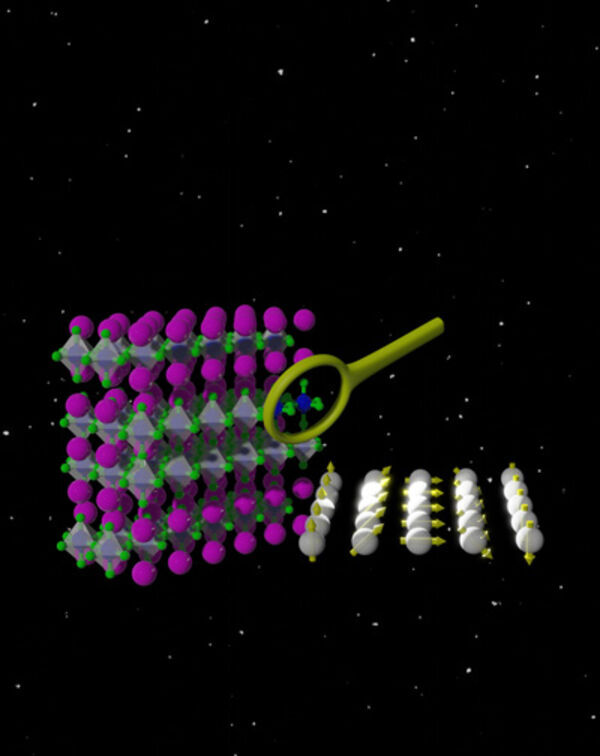
New Design Principles for Spin-based Quantum Materials
"Criteria for designing targeted quantum materials could support Internet of Things devices and other resource-intensive technologies As our lives become increasingly intertwined with technology — whether supporting communication while working remotely or streaming our favorite show — so too does our reliance on the data these devices create. Data centers supporting these technology ecosystems produce a significant carbon footprint — and consume 200 terawatt hours of energy each year, greater than the annual energy consumption of Iran. To balance ecological concerns yet meet growing demand, advances in microelectronic processors — the backbone of many Internet of Things (IoT) devices and data hubs — must be efficient and environmentally friendly. Northwestern Engineering materials scientists have developed new design principles that could help spur development of future quantum materials used to advance (IoT) devices and other resource-intensive technologies while limiting ecological damage. “New path-breaking materials and computing paradigms are required to make data centers more energy-lean in the future,” said James Rondinelli, professor of materials science and engineering and the Morris E. Fine Professor in Materials and Manufacturing at the McCormick School of Engineering, who led the research. The study marks an important step in Rondinelli’s efforts to create new materials that are non-volatile, energy efficient, and generate less heat — important aspects of future ultrafast, low-power electronics and quantum computers that can help meet the world’s growing demand for data." [...]
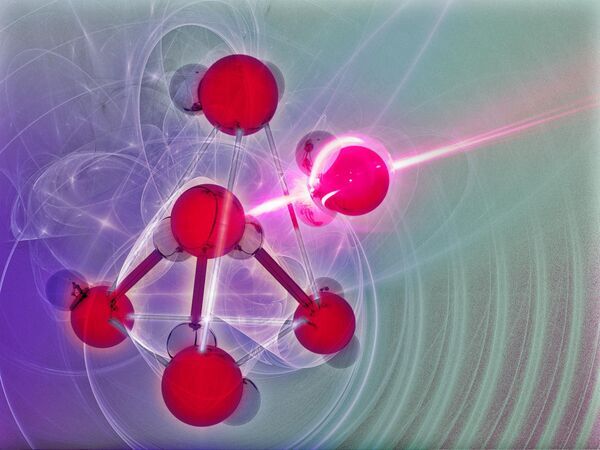
Supercooled Water Is a Stable Liquid, Scientists Show for the First Time
"First-ever measurements provide evidence that extremely cold liquid water exists in two distinct structures that co-exist and vary in proportion dependent on temperature Supercooled water is really two liquids in one. That’s the conclusion reached by a research team at the U.S. Department of Energy’s Pacific Northwest National Laboratory after making the first-ever measurements of liquid water at temperatures much colder than its typical freezing point. The finding, published today in the journal Science, provides long-sought experimental data to explain some of the bizarre behavior water exhibits at extremely cold temperatures found in outer space and at the far reaches of Earth’s own atmosphere. Until now, liquid water at the most extreme possible temperatures has been the subject of competing theories and conjecture. Some scientists have asked whether it is even possible for water to truly exist as a liquid at temperatures as low as -117.7 F (190 K) or whether the odd behavior is just water rearranging on its inevitable path to a solid. The argument matters because understanding water, which covers 71 percent of the Earth’s surface, is critical to understanding how it regulates our environment, our bodies and life itself." [...]
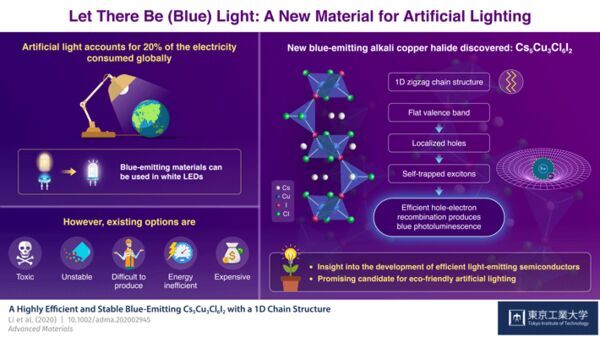
Shedding Light on the Development of Efficient Blue-Emitting Semiconductors
"Scientists at Tokyo Institute of Technology (Tokyo Tech) have discovered a new alkali copper halide, Cs5Cu3Cl6I2, that emits pure blue light. The combination of the two halide ions, chloride and iodide, gives the material a crystalline structure made of zigzag chains and peculiar properties that result in highly efficient photoluminescence. This novel compound could be readily used to produce relatively inexpensive and eco-friendly white LEDs and reduce the energy used in the generation of everyday artificial light. Artificial light accounts for approximately 20% of the total electricity consumed globally. Considering the present environmental crisis, this makes the discovery of energy-efficient light-emitting materials particularly important, especially those that produce white light. Over the last decade, technological advances in solid-state lighting, the subfield of semiconductors research concerned with light-emitting compounds, has led to the widespread use of white LEDs." [...]

Defying a 150-year-old rule for phase behavior
"Frozen water can take on up to three forms at the same time when it melts: liquid, ice and gas. This principle, which states that many substances can occur in up to three phases simultaneously, was explained 150 years ago by the Gibbs phase rule. Today, researchers from Eindhoven University of Technology and University Paris-Saclay are defying this classical theory, with proof of a five-phase equilibrium, something that many scholars considered impossible. This new knowledge yields useful insights for industries that work with complex mixtures, such as in the production of mayonnaise, paint or LCD’s. The researchers have published their results in the journal Physical Review Letters. The founder of contemporary thermodynamics and physical chemistry is the American physicist Josiah Willard Gibbs." [...]
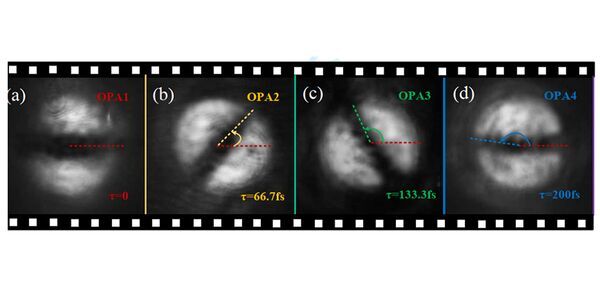
All-optical method sets record for ultrafast high-spatial-resolution imaging: 15 trillion frames per second
"New all-optical imaging technique with an unprecedented frame rate allows scientists to visualize ultrafast transient phenomena High-speed cameras can take pictures in quick succession. This makes them useful for visualizing ultrafast dynamic phenomena, such as femtosecond laser ablation for precise machining and manufacturing processes, fast ignition for nuclear fusion energy systems, shock-wave interactions in living cells, and certain chemical reactions. Among the various parameters in photography, the sequential imaging of microscopic ultrafast dynamic processes requires high frame rates and high spatial and temporal resolutions. In current imaging systems, these characteristics are in a tradeoff with one another. However, scientists at Shenzhen University, China, have recently developed an all-optical ultrafast imaging system with high spatial and temporal resolutions, as well as a high frame rate. Because the method is all-optical, it's free from the bottlenecks that arise from scanning with mechanical and electronic components." [...]
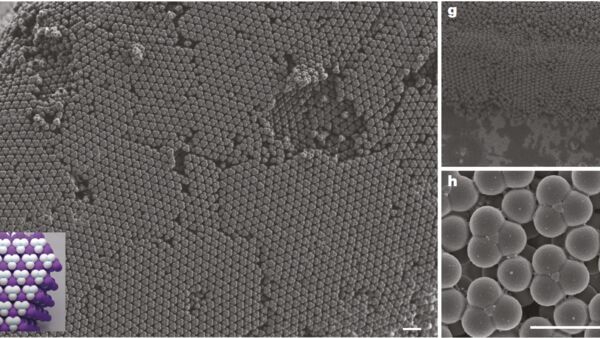
Tandon Researchers develop method to create colloidal diamonds
"The long-awaited photonic technique could change the way optical technologies are developed and used over the next decade. The colloidal diamond has been a dream of researchers since the 1990s. These structures — stable, self-assembled formations of miniscule materials — have the potential to make light waves as useful as electrons in computing, as well as a host of other applications. But while the idea of colloidal diamonds was developed decades ago, no one was able to reliably produce the structures. Until now. Researchers led by David Pine, professor of chemical and biomolecular engineering at the NYU Tandon School of Engineering and professor of physics at NYU, have devised a new process for the reliable self-assembly of colloids in a diamond formation that could lead to cheap, scalable fabrication of such structures." [...]

UCLA scientists create world’s smallest ‘refrigerator’
"How do you keep the world’s tiniest soda cold? UCLA scientists may have the answer. A team led by UCLA physics professor Chris Regan has succeeded in creating thermoelectric coolers that are only 100 nanometers thick — roughly one ten-millionth of a meter — and have developed an innovative new technique for measuring their cooling performance. “We have made the world’s smallest refrigerator,” said Regan, the lead author of a paper on the research published recently in the journal ACS Nano. To be clear, these miniscule devices aren’t refrigerators in the everyday sense — there are no doors or crisper drawers. But at larger scales, the same technology is used to cool computers and other electronic devices, to regulate temperature in fiber-optic networks, and to reduce image “noise” in high-end telescopes and digital cameras." [...]
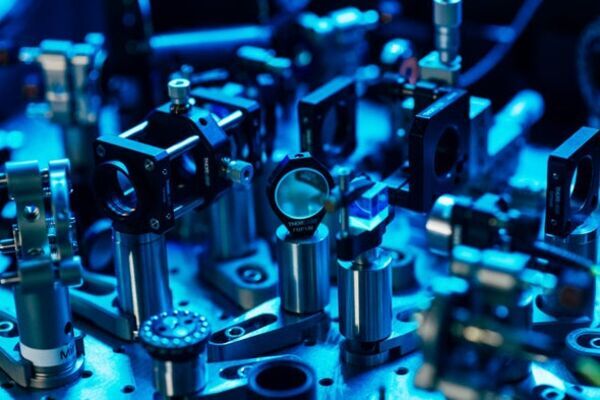
Physicists Create City-Sized Ultrasecure Quantum Network
"Capable of connecting eight or more users across distances of 17 kilometers, the demonstration is another milestone toward developing a fully quantum Internet Quantum cryptography promises a future in which computers communicate with one another over ultrasecure links using the razzle-dazzle of quantum physics. But scaling up the breakthroughs in research labs to networks with a large number of nodes has proved difficult. Now an international team of researchers has built a scalable city-wide quantum network to share keys for encrypting messages. The network can grow in size without incurring an unreasonable escalation in the costs of expensive quantum hardware. Also, this system does not require any node to be trustworthy, thus removing any security-sapping weak links. “We have tested it both in the laboratory and in deployed fibers across the city of Bristol” in England, says Siddarth Koduru Joshi of the University of Bristol." [...]

NIST Scientists Reveal the Power Behind the Curtain - With Neutrons
"Technique could permit detection of electric fields in hard-to-reach places, with potential security value. In a potential step forward for imaging technology, scientists from the National Institute of Standards and Technology (NIST) and Sandia National Laboratories have developed a way to use neutrons to detect electric fields in spaces that are unreachable by conventional probes. Their nondestructive but penetrative method, described in the journal Physical Review Letters, could lead to sensing devices that can see through walls to detect the electric fields in electronic components — a clearly useful capability for security screening and other diagnostic applications. “This is the first time anyone has been able to image an electric field that has been physically isolated,” said Dan Hussey, a NIST physicist. “There could be something that you don’t want to disassemble but want to inspect. This approach might offer a way to see its electric fields even though barriers stand in the way.” The technique requires an intense beam of polarized neutrons, the particles that together with protons form the nuclei of all elements other than simple hydrogen." [...]
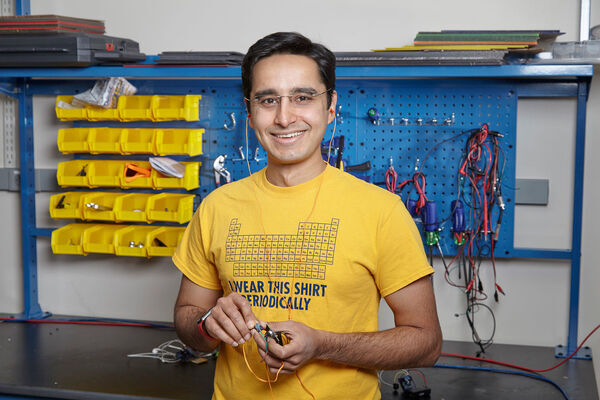
This $1 hearing aid could treat millions with hearing loss
"As an undergraduate in Mumbai, India, Saad Bhamla wanted to do something nice for his maternal grandparents: Buy them a pair of hearing aids. But the prices were shockingly high—and far beyond his means. Now, 15 years later, the bioengineer has invented a device to help grandparents across the globe: a do-it-yourself hearing aid made from inexpensive, easy-to-find parts. The no-frills device, described in a new study, could help restore hearing to millions suffering from age-related hearing loss—for less than the price of a bottle of water. The new device is “incredibly compelling,” says Frank Lin, an ear, nose, and throat doctor at the Cochlear Center for Hearing and Public Health at Johns Hopkins University who was not involved in the work. Globally, 230 million people aged 65 and older experience age-related hearing loss." [...]

Promising computer simulations for stellarator plasmas
"Path to higher thermal insulation of the plasma / Reduction of plasma turbulence The turbulence code GENE (Gyrokinetic Electromagnetic Numerical Experiment), developed at Max Planck Institute for Plasma Physics (IPP) at Garching, Germany, has proven to be very useful for the theoretical description of turbulence in the plasma of tokamak-type fusion devices. Extended for the more complex geometry of stellarator-type devices, computer simulations with GENE now indicate a new method to reduce plasma turbulence in stellarator plasmas. This could significantly increase the efficiency of a future fusion power plant. For the fusion researchers at IPP, who want to develop a power plant based on the model of the sun, the turbulence formation in its fuel – a hydrogen plasma – is a central research topic. The small eddies carry particles and heat out of the hot plasma centre and thus reduce the thermal insulation of the magnetically confined plasma. Because the size and thus the price of electricity of a future fusion power plant depends on it, one of the most important goals is to understand, predict and influence this “turbulent transport”." [...]
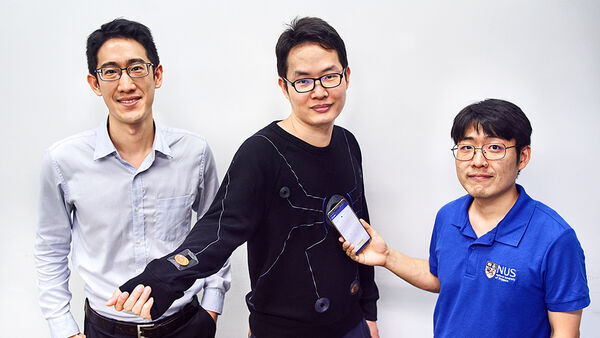
NUS team develops smart suit wirelessly powered by a smartphone
"Athletes are always on the lookout for new ways to push the limits of human performance and one needs to first pinpoint their current limits objectively if they seek to overcome them. A team of researchers from NUS has developed a smartphone-powered suit capable of providing athletes with physiological data such as their posture, running gait and body temperature while they are out on the field. The current technology used to monitor athlete performance range from small wearable fitness trackers to elaborate clinical monitoring equipment. Fitness trackers are compact and lightweight but are only able to collect data from a single point which is insufficient to generate meaningful insights. Clinical monitoring equipment can incorporate multiple sensors to capture data from various points on the athlete’s body, but are mired in tangles of wires and is too bulky to be used outdoors. The ideal system would allow researchers to collect data from multiple sensors at different points on the athlete’s body in an outdoor environment while keeping bulk, weight and wires to an absolute minimum." [...]
Modelos 3D
Com a disponibilidade de ferramentas que permitem dar azo a nossa imaginação na criação de peças 3D e espaços como o thingiverse para as publicar, esta rubrica apresenta alguns modelos selecionados que poderão ser úteis.
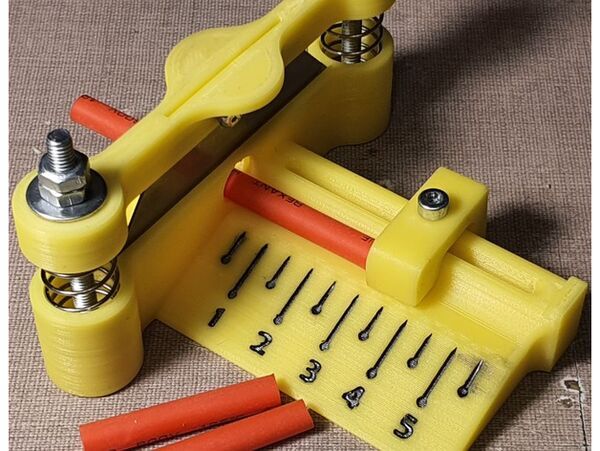
Heat-shrink tube cutter
"Print base with supports only from buildplate. Maximum diametre of the tube is 10 mm. For assemly you'll need: 2 - 12x30mm springs (you can use it whithout springs) 2 - M4x40mm bolts 2 - M4 nuts 3 - M3x10 bolts (to fix the blade and stopper) 3 - M3 nuts" [...]
Documentação
A documentação é parte essencial do processo de aprendizagem e a Internet além de artigos interessantes de explorar também tem alguma documentação em formato PDF interessante de ler. Todos os links aqui apresentados são para conteúdo disponibilizado livremente pelo editor do livro.

HackSpace magazine #35
"Forget the world of work for a while and build a full-sized arcade cabinet, complete with clicky buttons, joystick and even a coin machine to extort money from yourself. We’ll guide you through all the steps needed to make your own personal time wasting machine, from cutting the MDF to setting up your retro gaming platform. - Ponder Schrödinger’s blinkenlights - Send signals the only fashioned way with touch-tones - Discover new things to do with plywood - Defeat the sun’s rays with ASA 3D printing" [...]

The MagPI 98
"Discover Raspberry Pi portable computing in the latest edition of The MagPi. Inside The MagPi magazine #98 - Build a portable computer. Code on-the-go with the Raspberry Pi 2Go portable workstation. - Play classic console games. Discover a range of ways to buy and source classic games legally for Raspberry Pi. - PiBoy DMG." [...]

newelectronics 22 Setembro 2020
"New Electronics is a fortnightly magazine focusing on technological innovation, news and the latest developments in the electronics sector. Downloadable as a digital page turner or pdf file, or offered as a hard copy, the New Electronics magazine is available in a format to suit you. " [...]
Projetos Maker
Diversos Projetos interessantes.

Wi-Fi Multi-Meter
"Welcome Everyone, Simple Hobby thought come to alive using ESP8266-01 with INA219 (current shunt and power monitor). hello everyone, when am working on solar project which charging battery from an solar I need to monitor the current an voltage going to battery, but I can not put an multimeter all time and watch the data and analyze it from remote area. so simple thought comes with mixing of soo many things finally am here to publish my project. IDEA for power monitoring am using a sensor INA219 a current shunt and power monitor with an I2C- or SMBUS-compatible interface, IF am use Arduino again I need to think about remote monitoring because Arduino boards don't having inbuilt Wi-Fi option, so am using an ESP8266-01 because it is a cheap and having i2c, Wi-Fi. " [...]

Unopad - Arduino MIDI pad controller
"Tutorial for creating simple MIDI controller and usage of it in Ableton Live. Most tutorials and projects for Midi controllers are based only on an explanation of the Arduino work, but not so much on using it in the DAW itself. I wanna to create a tutorial with all the necessary things in one place . With this project, I wanted to help beginners to better understand the process of creating and using a controller, and I hope that it will be useful to someone. I have wanted to make a midi controller for a long time and I finally did it and now I will share the project with you. I used an Arduino Uno which does not have the ability to send MIDI messages via USB, so special programs had to be used for that (will be explained later in the text)." [...]
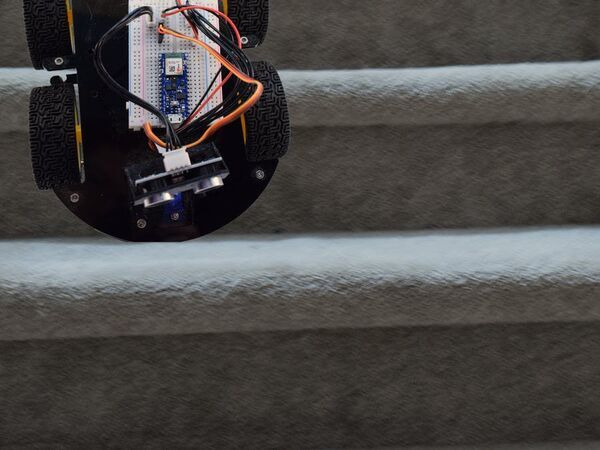
Robot Fall Detection with Edge Impulse
"How do you tell the difference between a fall and a sudden, normal movement? Train a machine learning model to detect when a fall occurs. The Idea Imagine creating a simple robot that can navigate around a room on its own using some kind of distance sensor. It does well at first, since it can dart between the legs of a table and avoid running into the wall. But there is a problem: it is prone to falling off the edge of the stairs. After falling down, it continues to attempt to run as normal, which wastes power and can cause more damage." [...]

Reverse-engineering the first FPGA chip, the XC2064
"A Field-Programmable Gate Array (FPGA) can implement arbitrary digital logic, anything from a microprocessor to a video generator or crypto miner. An FPGA consists of many logic blocks, each typically consisting of a flip flop and a logic function, along with a routing network that connects the logic blocks. What makes an FPGA special is that it is programmable hardware: you can redefine each logic block and the connections between them. The result is you can build a complex digital circuit without physically wiring up individual gates and flip flops or going to the expense of designing a custom integrated circuit. The FPGA was invented by Ross Freeman1 who co-founded Xilinx2 in 1984 and introduced the first FPGA, the XC2064. 3 This FPGA is much simpler than modern FPGAs—it contains just 64 logic blocks, compared to thousands or millions in modern FPGAs—but it led to the current multi-billion-dollar FPGA industry." [...]
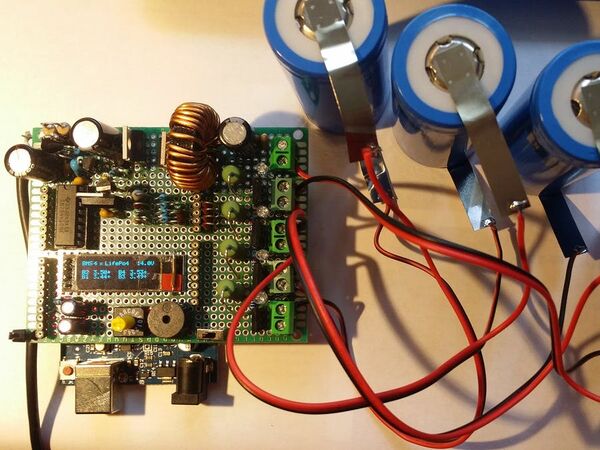
Li-ion LifePo4 1S to 4S BMS Charger Tester with Arduino Uno
"This is a BMS charger that would be as universal as possible for testing Li-ion or LifePo4 cells. Story It can be strange to study a BMS in regard of the overall choice available on the market for quite a very low price.However, the objective of this project is to build a charging and testing device that can be universal, for a different among of cells to charge and for different technologies. The Arduino Uno based device, manage voltage readings, and according to results manages cells’ shunt or a buzzer. A SSD screen displays where we are. A buck DC-DC converter adjust the charging voltage for a constant charging current. Whatever if you have the habit or if you are starting in the modern batteries world – e-bikes batteries repair, solar powered systems, etc.… - you can notice that it is not easy to manage Li-ion norLifePo4 cells: · When you repair a battery pack, if it is easy to detect a dead cell, how do you detect a half-dead one?" [...]

Honda Motorcycle Dash
"This is my attempt to build an information display / dashboard replacement (or additon) for modern Honda motorcycles. It connects to the bike via its diagnostic port and reads information directly from the ECU It also contains a GPS module and support for an ambient temperature / humidity sensor The below hardware is used in the current design. For further information see the hardware section of the wiki Espressif ESP32 (Node32S for development, ESP32WROOM for build) 2.8" ILI9341 based SPI TFT Display DHT22 Temperature/Humidity Sensor Serial GPS Module L9637D Monolithic bus driver with ISO 9141 interface" [...]
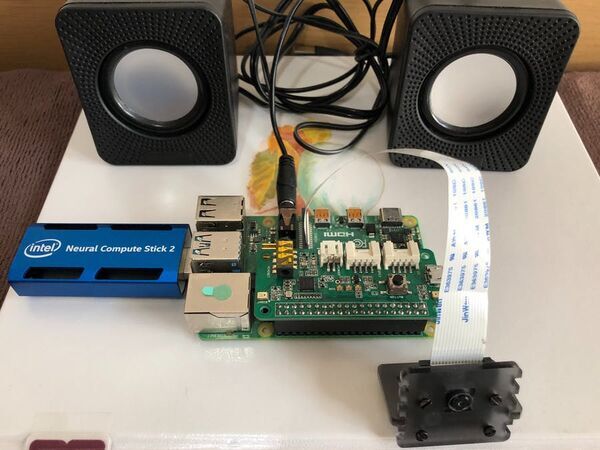
Teachable Machine
"A voice-enabled machine which reads book and replies to the questions. Introduction In this project I built a voice-enabled teachable machine which can scan text from a book pages or any text source and convert that to a context and users can ask questions related to that context and the machine can answer just using the context. I always wanted to make such kind of edge device which is easy to deploy and can be trained for a given context effortlessly without needing any internet connection. Machine Learning Models used in the Application Three machine learning models are used: 1. Tesseract OCR (LSTM based model) Tesseract is an OCR engine with support for unicode and the ability to recognize more than 100 languages out of the box. It can be trained to recognize other languages." [...]
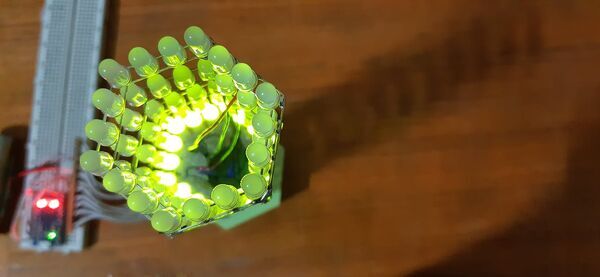
LED Tower
"Made a LED tower with 180 LEDs and used Pro Micro in order to control them in sequence. So I was browsing Thingiverse for LEDs Jigs and found this great JIG designed by Mohit Bhote https://www.thingiverse.com/thing:3147406 I look at it and I was like I have to make an LED tower with this! so I did. " [...]
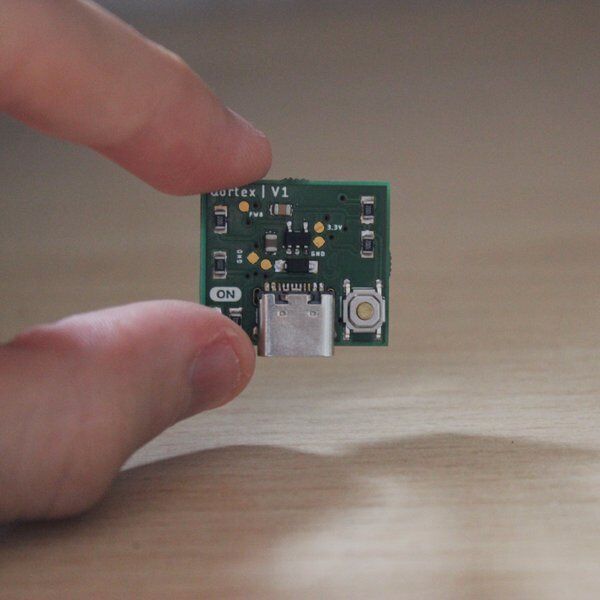
How I tracked +500 people with ESP8266
"This is how I made a custom device to legally track people via their smartphones Before getting into detail, this project was done legally within the legal limits, so please if you're going to build like this then use it at your own responsibility :). It all started as a quick project for checking the connection status of my IoT plant sensors. I was studying my first year as an electronics engineer so I was pretty obsessed with making sure that anything could speak to the internet, or at least that's what I tried :). While doing some research I had found that many people where using the so called "probe requests" frames sent by smartphones, laptops and wifi devices to announce the SSID they were connected to. In other words, your phone or laptop is constantly searching for all WiFi networks which you already connected in the past (unless you did remove as "saved"), sharing information to anyone who is listening for those public packets: where you have been before and your unique device MAC address. " [...]
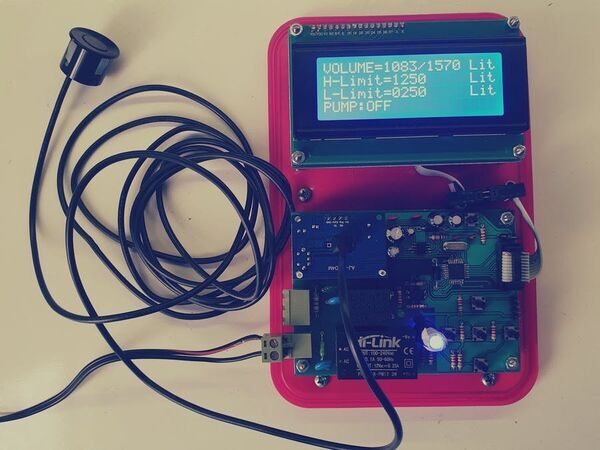
UltraSonic Liquid Level Controller
"A Simple ultrasonic liquid level controller based on STM32 microcontroller Introduction As you probably know, Iran has dry weather, and there is a lack of water in my country. Sometimes, especially in the summer, it can be seen that the government cuts the water. So most of the apartments have a water tank. There is a 1500 litre tank in our apartment which provides water. Also, there are 12 residential units in our apartment. As a result, it can be expected that the tank goes empty very soon." [...]

Parking Assist Stoplight
"Park in your garage with perfect consistency! No more hitting the garage door or workbench! I am finally able to park in a garage, which takes some getting used to. I like to have as much space as possible to access the workbench along the back wall, but trying to get as close to the garage door has caused some...problems. This device senses the distance of the object in front of it (a vehicle) and depending on range, one of three lights will turn on. Green = Keep Driving Yellow = Approaching Stopping Point Red = Stop!" [...]
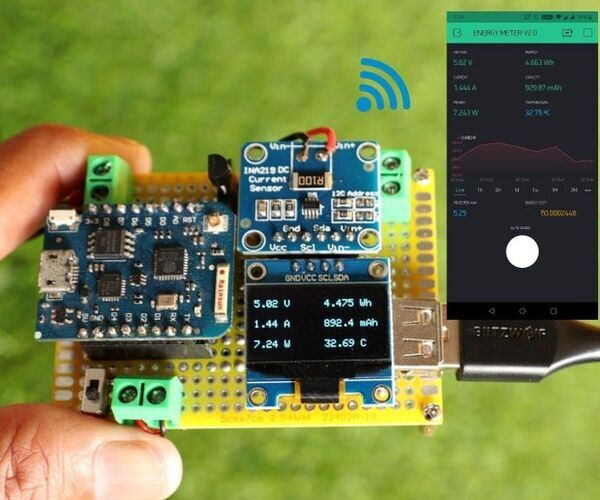
DIY Multifunction Energy Meter V2.0
"In this Instructable, I will show you how to make a Wemos ( ESP8266 ) based Multifunction Energy Meter. This little Meter is a very useful device that monitors voltage, current, power, energy, and capacity. Apart from these it also monitors the ambient temperature which is important for solar photovoltaic application. This device is suitable for almost any DC device. This small meter can also be used for measuring the real capacity of the battery pack or power bank using a dummy load. The Meter can measure up to voltage range from 0 - 26V and a maximum current of 3.2A." [...]
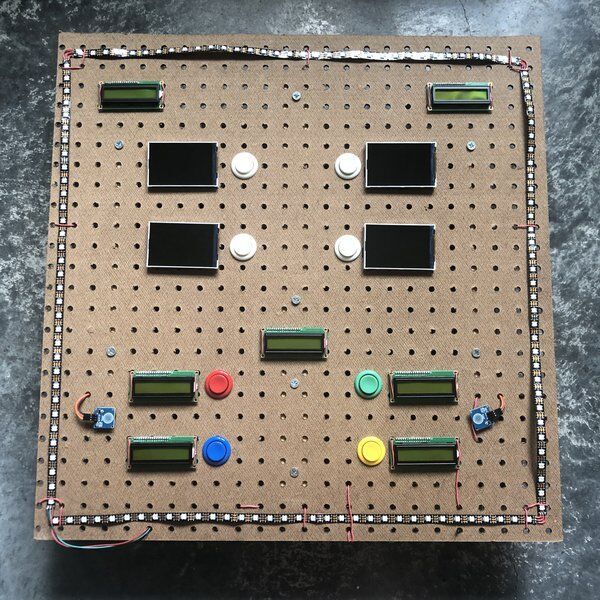
Greek Vocabulary Reviewer
"Greek language vocabulary reviewer via an interactive panel game with arcade pushbuttons, LCD screens, LEDs and more. This project involves creating an interactive panel game with Arduino components to help review Greek vocabulary in a fun way that feels similar to an arcade game. You can add vocabulary words and associated images / voice recordings to the code base as you learn them, so this project can always be expanded upon. Considering that children (ages 6-12) typically understand around 12,000 words, I quickly began to realize that this would be no easy project. What makes this project more difficult, is the fact that there are no agreed upon lists of words to introduce based on grade level. So I ended up compiling my own list of words and split them up into different categories (e.g." [...]
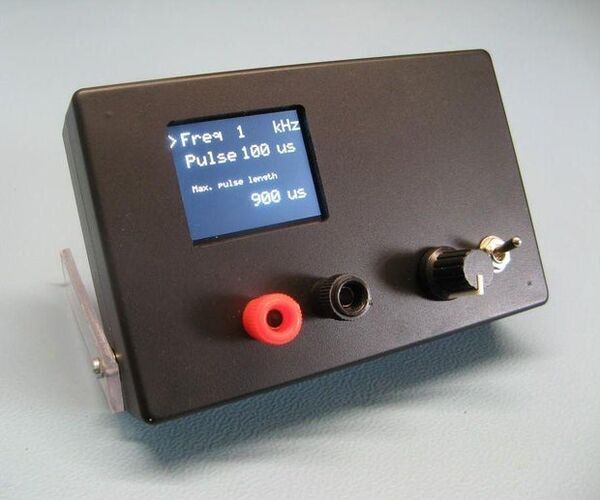
Pulse Generator
"When you need pulses of any sort, long, short and with variable frequency you can use one or two 555 timers. That works, is easy to set up and is cheap. But it also limited to a certain range in frequency and pulse length. If you want a precise pulse length you will need an oscilloscope to check it. The same goes for when you want an exact frequency. I needed pulses of exactly 1us, 5us, 1ms and 5ms, I decided that trying to do that with 555 timers was not what I wanted." [...]

Digital Level With Cross-Line Laser
"Hi everyone, today I'm going to show you how to make a digital level with optional integrated cross-line laser. About a year ago I created a digital multi-tool. While that tool does feature a lot of different modes, for me, the most common and useful are the level and angle measuring modes. So, I thought it would be productive to make a new, more compact tool focused only on angle sensing. The assembly is straight forward, so hopefully it will be a fun weekend project for people. I've also designed a sled to hold the level while using the cross-line laser." [...]
That's all Folks!



